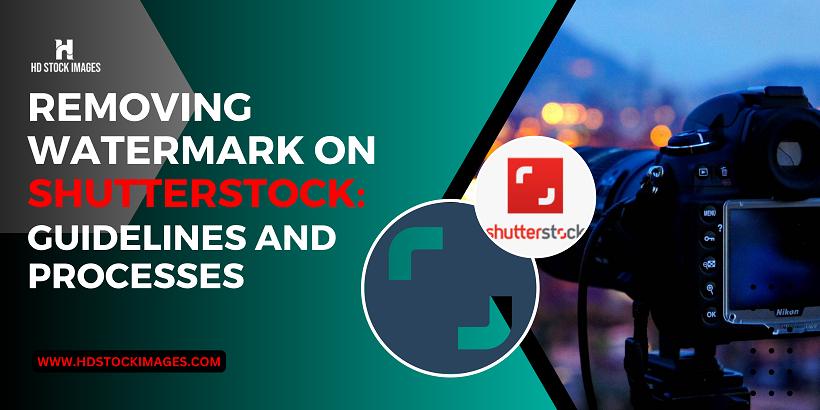1. Introduction
Watermarks on Shutterstock images serve as a protective measure to prevent unauthorized use and distribution of copyrighted content. However, there are situations where individuals may need to remove watermarks for legitimate purposes. In this blog post, we will explore the guidelines and processes involved in removing watermarks on Shutterstock images.Watermarks are often placed on images to deter copyright infringement and ensure proper attribution to the original creator. While it is generally advised to respect copyright laws and use images with proper licensing, there are instances where watermark removal becomes necessary, such as for personal use, testing, evaluation, or educational projects.Also Read This: how do i get my liscened adobe stock onto ai
2. Use online Shutterstock watermark remover by HD stock images
 The Shutterstock Watermark Remover is a tool that allows you to quickly and easily remove watermarks from Shutterstock images. It is a fast, easy-to-use, and affordable tool that can save you time and money. With this tool, you can remove watermarks from Shutterstock images without any hassle. It is a great way to save time and money when you need to use Shutterstock images for your projects.To use the Shutterstock Watermark Remover, simply upload the image you want to remove the watermark from and the tool will do the rest. The tool is compatible with all major operating systems and browsers.The Shutterstock Watermark Remover is a great way to get high-quality Shutterstock images without having to pay for a subscription. It is a quick, easy, and affordable way to remove watermarks from Shutterstock images.
The Shutterstock Watermark Remover is a tool that allows you to quickly and easily remove watermarks from Shutterstock images. It is a fast, easy-to-use, and affordable tool that can save you time and money. With this tool, you can remove watermarks from Shutterstock images without any hassle. It is a great way to save time and money when you need to use Shutterstock images for your projects.To use the Shutterstock Watermark Remover, simply upload the image you want to remove the watermark from and the tool will do the rest. The tool is compatible with all major operating systems and browsers.The Shutterstock Watermark Remover is a great way to get high-quality Shutterstock images without having to pay for a subscription. It is a quick, easy, and affordable way to remove watermarks from Shutterstock images.Here are some of the benefits of using the Shutterstock Watermark Remover:
- It is fast and easy to use.
- It is affordable.
- It is compatible with all major operating systems and browsers.
- It removes watermarks without affecting the quality of the image.
Here are the steps on how to use the Shutterstock Watermark Remover:
- Go to the Shutterstock Watermark Remover website.
- Click on the "Upload Image" button.
- Select the Shutterstock image you want to remove the watermark from.
- Click on the "Remove Watermark" button.
- The tool will automatically remove the watermark from the image.
- You can download the watermark-free image.
Here are some additional tips for using the Shutterstock Watermark Remover:
- The tool works best on images with high-contrast watermarks.
- If the watermark is too dark or blurry, the tool may not be able to remove it completely.
- You can try adjusting the settings of the tool to improve the results.
- If you are not satisfied with the results, you can try using a different watermark removal tool.
Here are some of the limitations of the Shutterstock Watermark Remover:
- It cannot remove watermarks from videos.
- It cannot remove watermarks from images that are too small or too low in quality.
- It may not be able to remove watermarks that are too dark or blurry.
Also Read This: How Much Does Getty Images Pay for Photos
3. Situations Where Watermark Removal is Appropriate
 While watermark removal is generally discouraged due to copyright and ethical considerations, there are specific situations where it may be deemed appropriate. It is important to approach watermark removal with caution and ensure that it aligns with legal and ethical standards. Here are some situations where watermark removal may be considered:
While watermark removal is generally discouraged due to copyright and ethical considerations, there are specific situations where it may be deemed appropriate. It is important to approach watermark removal with caution and ensure that it aligns with legal and ethical standards. Here are some situations where watermark removal may be considered:- Personal Use and Non-commercial Projects: If you intend to use the image for personal purposes, such as creating a wallpaper for your computer or printing it for your personal collection, watermark removal may be acceptable. However, it is crucial to respect the terms of service and licensing agreements of Shutterstock.
- Testing and Evaluation Purposes: Watermark removal may be necessary when testing or evaluating the image quality, composition, or suitability for a project. This includes situations where you need to assess the image's potential before making a purchase or obtaining the necessary licenses.
- Educational and Research Projects: In the context of education or research, where the use of images is for non-commercial, educational purposes, watermark removal may be justified. However, it is essential to adhere to fair use guidelines and give proper attribution to the original creator, if applicable.
- Fair Use and Transformative Work: In certain cases, the use of watermarked images may fall under fair use or transformative work exceptions. Fair use allows for the limited use of copyrighted material without permission, such as for commentary, criticism, or parody. Transformative work involves creating something new from the original content, such as through remixing or creating derivative works.
Also Read This: Getty Images Reverse Image Search: Discover Similar or Exact Images
4. Guidelines for Removing Watermarks on Shutterstock
When considering the removal of watermarks on Shutterstock images, it is essential to adhere to specific guidelines to ensure compliance with copyright laws and ethical standards. Here are some guidelines to follow when removing watermarks on Shutterstock:- Reading and Understanding Shutterstock's Terms of Service: Before using any images from Shutterstock, thoroughly read and understand their terms of service. These terms outline the permitted uses of their images, restrictions, and guidelines for usage. Ensure that watermark removal is not explicitly prohibited or restricted in the terms.
- Obtaining Proper Licenses and Permissions: Whenever possible, it is best to obtain the appropriate licenses or permissions from Shutterstock to use their images without watermarks. This ensures that you are legally and ethically using the images and respecting the rights of the original creators. Explore Shutterstock's licensing options to find the most suitable license for your needs.
- Exploring Alternative Licensing Options: If obtaining a license from Shutterstock is not feasible, consider exploring alternative licensing options. There are other stock image websites or platforms that offer images under different licensing terms. Ensure that you understand and comply with the specific licensing requirements for the images you choose.
- Utilizing Shutterstock's Authorized Watermark-Free Image Collection: Shutterstock provides a collection of images that are available without watermarks for specific uses. These images can be accessed through their authorized watermark-free image collection. Ensure that you qualify for the intended use of these images and follow any guidelines or restrictions associated with their usage.
Also Read This: How to Add a Download Button in Behance to Allow Visitors to Download Your Work
5. Processes for Removing Watermarks
Removing watermarks from Shutterstock images can be accomplished using various processes, ranging from manual methods to automated tools. Here are some common processes for removing watermarks:A. Manual Methods Using Photo Editing Software:
Cloning and Healing Tools: Photo editing software like Adobe Photoshop offers cloning and healing tools that allow you to manually remove watermarks. Carefully clone or heal the areas around the watermark to seamlessly blend them with the rest of the image.Content-Aware Fill and Patching Techniques: Utilize content-aware fill or patching techniques available in software like Adobe Photoshop to intelligently remove the watermark. These tools analyze the surrounding pixels and fill in the area where the watermark was present.B. Automated Tools and Software:
Automated tools and software can assist in removing watermarks, although their effectiveness may vary depending on the complexity of the watermark and the image itself. Some tools use algorithms to automatically detect and remove watermarks, but results may not always be satisfactory, and additional manual editing might be required.C. Hiring Professional Services for Watermark Removal:
If you require high-quality results or lack the necessary skills or time to remove watermarks yourself, consider hiring professional services specializing in watermark removal. These professionals have expertise in photo editing and can ensure that the watermark is removed seamlessly while maintaining image quality and integrity.Regardless of the method chosen, it is crucial to exercise caution and follow ethical practices. Ensure that the removal of watermarks is done within the bounds of the law and respects the rights of the original creators. Always consider alternative options, such as obtaining proper licenses or using images without watermarks from authorized sources, whenever possible.In the next section, we will discuss the risks and consequences associated with improper watermark removal, emphasizing the importance of responsible practices in this regard.Also Read This: How to Upload Your Portfolio to Behance for a Professional Display
6. Risks and Consequences of Improper Watermark Removal
Improper removal of watermarks from Shutterstock images can have significant risks and consequences, both legally and ethically. It is crucial to be aware of these potential ramifications before engaging in any watermark removal activities. Here are some risks and consequences to consider:- Legal Implications and Copyright Infringement: Removing watermarks without proper authorization or licenses can constitute copyright infringement. Copyright laws protect the rights of the original creators, and unauthorized use or distribution of copyrighted content can lead to legal action, including financial penalties and damages. It is essential to respect the intellectual property rights of others and comply with copyright laws.
- Damage to Reputation and Credibility: Engaging in improper watermark removal practices can damage your reputation and credibility. It can be viewed as unethical behavior and reflect poorly on your personal or professional character. Respect for intellectual property rights and ethical practices is important in maintaining trust and credibility within creative communities and industries.
- Penalties and Consequences from Shutterstock: Shutterstock, as a provider of stock images, has its own terms of service and guidelines for image usage. Violating these terms, including unauthorized watermark removal, can result in penalties imposed by Shutterstock. This may include account suspension, termination of licensing agreements, or legal actions by the company.
Also Read This: Complete Guide to Selling Getty Images as a Contributor
7. Alternatives to Removing Watermarks
Instead of removing watermarks from Shutterstock images, there are alternative approaches you can consider to obtain images legally and ethically. These alternatives provide options for finding and using images without the need for watermark removal. Here are some alternatives:- Explore Free or Low-Cost Stock Image Websites: There are numerous websites that offer free or low-cost stock images under various licensing agreements. Examples include Unsplash, Pixabay, and Pexels. These platforms provide a wide range of high-quality images that can be used for personal and commercial purposes without the need for watermark removal.
- Utilize Creative Commons Licensed Images: Creative Commons licenses offer a range of permissions that allow creators to share their work under specific conditions. Websites like Creative Commons Search, Wikimedia Commons, and Flickr's Creative Commons section provide access to a vast collection of images with different usage rights. Ensure that you understand and comply with the specific requirements of each Creative Commons license.
- Create Original Content or Use Public Domain Images: Consider creating your own original content or utilizing images in the public domain. By creating your own images or using those that are not subject to copyright restrictions, you can avoid the need for watermark removal altogether. Public domain images are those whose copyright has expired or were released into the public domain by the creator, allowing unrestricted use.

 admin
admin








